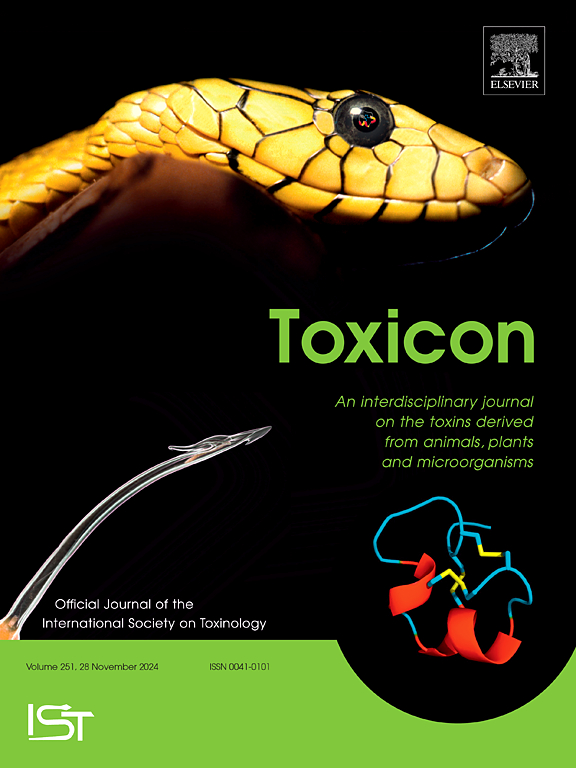毛喉蚁对实验性小鼠妊娠模型和小鼠后代的影响
IF 2.6
4区 医学
Q2 PHARMACOLOGY & PHARMACY
引用次数: 0
摘要
蝎子中毒在摩洛哥是一个公共卫生问题,在那里,毛里塔尼亚雄蝎子被认为是最危险的蝎子。这种蝎子很好地适应了城市环境,人类接触到它的毒液的可能性越来越高,包括怀孕期间。本研究旨在探讨单次皮下注射中等剂量的蛇毒是否会对妊娠小鼠的生殖性能和后代发育产生不利影响。在研究发育神经毒性之前,我们评估了毛利塔尼亚雄鳗毒液对小鼠的急性毒性。随后,在妊娠第5天(GD5)、第10天(GD10)和第15天(GD15)给药200 μg/kg的毒液。利用神经行为学、发育学、血液学和生物化学方法,我们研究了毛利塔尼雄毛虫中毒对怀孕小鼠的影响。此外,我们研究了氧化应激在毒液对生殖性能和后代发育的有害影响中的作用。我们的研究结果表明,在怀孕和非怀孕的小鼠中,毛利塔尼雄蛾毒液引起相似的中毒症状,但在妊娠第10天和第15天给药时引起阴道出血和流产。毒液还引发了生化、血液学和酶的破坏。活力指数、泌乳量和子代生长显著降低,形态发育明显迟缓。最后,胎儿在子宫内暴露于毒液后,其感觉运动功能严重受损,影响其社会行为、感觉成熟和运动协调。本研究结果表明,妊娠期给予中剂量的毛塔尼雄鳗毒液对其产后身体发育和反射成熟有显著影响。本文章由计算机程序翻译,如有差异,请以英文原文为准。

Effects of Androctonus mauritanicus envenomation on an experimental mouse model of pregnancy and on mouse offspring
Scorpion envenomation is a public health issue in Morocco, where Androctonus mauritanicus is considered the most dangerous scorpion. This scorpion is well adapted to urban environments, and the likelihood of human exposure to its venom is increasingly high, including during pregnancy.
This study was designed to investigate whether a single subcutaneous injection of venom at a moderate envenomation dose in pregnant mice could lead to detrimental effects on maternal reproductive performance and offspring development.
Prior to examining developmental neurotoxicity, we assessed the acute toxicity of Androctonus mauritanicus venom in mice. Subsequently, the venom (200 μg/kg) was administered to pregnant mice on gestational day 5 (GD5), 10 (GD10), or 15 (GD15). Using neurobehavioral, developmental, hematological, and biochemical approaches, we investigated the consequences of Androctonus mauritanicus envenomation in pregnant mice. Additionally, we examined the role of oxidative stress in the venom's deleterious effects on reproductive performance and offspring development.
Our results show that Androctonus mauritanicus venom induces similar envenomation symptoms in pregnant and non-pregnant mice but causes vaginal bleeding and abortions when administered on gestational days 10 and 15. The venom also triggered biochemical, hematological, and enzymatic disruptions. Viability indices, lactation, and offspring growth were significantly reduced, along with noticeable morphological delays. Finally, sensorimotor functions of offspring exposed to venom in utero were severely impaired, affecting their social behavior, sensory maturation, and motor coordination.
Based on the findings of this study, Androctonus mauritanicus venom administration during pregnancy at a moderate dose can lead to significant effects on physical development and reflex maturation during the postnatal period.
求助全文
通过发布文献求助,成功后即可免费获取论文全文。
去求助
来源期刊

Toxicon
医学-毒理学
CiteScore
4.80
自引率
10.70%
发文量
358
审稿时长
68 days
期刊介绍:
Toxicon has an open access mirror Toxicon: X, sharing the same aims and scope, editorial team, submission system and rigorous peer review. An introductory offer Toxicon: X - full waiver of the Open Access fee.
Toxicon''s "aims and scope" are to publish:
-articles containing the results of original research on problems related to toxins derived from animals, plants and microorganisms
-papers on novel findings related to the chemical, pharmacological, toxicological, and immunological properties of natural toxins
-molecular biological studies of toxins and other genes from poisonous and venomous organisms that advance understanding of the role or function of toxins
-clinical observations on poisoning and envenoming where a new therapeutic principle has been proposed or a decidedly superior clinical result has been obtained.
-material on the use of toxins as tools in studying biological processes and material on subjects related to venom and antivenom problems.
-articles on the translational application of toxins, for example as drugs and insecticides
-epidemiological studies on envenoming or poisoning, so long as they highlight a previously unrecognised medical problem or provide insight into the prevention or medical treatment of envenoming or poisoning. Retrospective surveys of hospital records, especially those lacking species identification, will not be considered for publication. Properly designed prospective community-based surveys are strongly encouraged.
-articles describing well-known activities of venoms, such as antibacterial, anticancer, and analgesic activities of arachnid venoms, without any attempt to define the mechanism of action or purify the active component, will not be considered for publication in Toxicon.
-review articles on problems related to toxinology.
To encourage the exchange of ideas, sections of the journal may be devoted to Short Communications, Letters to the Editor and activities of the affiliated societies.
 求助内容:
求助内容: 应助结果提醒方式:
应助结果提醒方式:


